Construction of Karst Landscape Ecological Security Pattern Based on Conflict between Human and Nature in Puzhehei
Abstract
1. Introduction
2. Materials and Methods
2.1. Study Area
2.2. Date Sources
- (1)
- Google Earth provided the Digital Elevation Model (DEM, ASTER GDEM 30 M)(https://earth.google.com.hk/, accessed on 19 December 2022);
- (2)
- The dataset of surface water and normalized differential vegetation index(NDVI, 30 m spatial resolution) were obtained from the Geospatial Data Cloud website (http://www.gscloud.cn/, accessed on 28 December 2020);
- (3)
- The distribution data and sensitivity data of rocky desertification were derived from the research results of Xu Hongfeng [24] et al.; the data were processed via Landsat through the Google Earth Engine cloud computing platform (accessed on 25 December 2020);
- (4)
- Soil erodible data were created using the China Soil Database at a scale of 1:1 million (https://vdb3.soil.csdb.cn/, accessed on 13 December 2022);
- (5)
- The roadway vector data were obtained through the OpenStreetMap website (https://www.openstreetmap.org/, accessed on 2 December 2022);
- (6)
- The land use data (10 m spatial resolution) were obtained from the European Space Agency (https://viewer.esa-worldcover.org/, accessed on 27 November 2022). Six different types of classifications were made for the current study region: forest land, water areas, grassland, cultivated land, unutilized land, and construction land. After accuracy verification, the Kappa coefficient was verified to be 0.9342, with an overall classification accuracy of 94.9013%.
2.3. Analysis Methods
2.3.1. Ecological Source Areas Identification
Identification of Landscape Elements Based on MSPA Analysis
Selection of Ecological Source Areas Based on Landscape Connectivity
2.3.2. Ecological Resistance Surface Construction and Correction
Ecological Resistance Surface Construction
Ecological Resistance Surface Correction
2.3.3. Ecological Corridor Identification and Importance Grading
Ecological Corridor Identification Based on the MCR Model
Ecological Corridor Identification Based on the Circuit Theory
Importance Classification of Ecological Corridor Based on the Gravity Model
2.3.4. Ecological Node Identification and Importance Grading
Ecological Node Identification
Importance Classification of Ecological Nodes
3. Results
3.1. Determination of Ecological Protection Source Areas
3.2. Construction of Ecological Resistance Surfaces
3.3. Ecological Corridor Identification and Importance Classification
3.4. Ecological Node Identification and Importance Classification
3.5. Construction of Karst Landscape Ecological Security Pattern of Puzhehei
4. Discussion
5. Conclusions
- (1)
- The findings of this study indicate that the Puzhehei karst area encompasses a total of 166.6572 km2 of ecological land, representing 46.06% of the present study area. Additionally, the ecological source areas within this region amount to 77.275 km2, accounting for 21.36% of the total study area.
- (2)
- The MCR model and circuit theory were utilized to identify a total of 78 ecological corridors, spanning a combined length of 545.186 km. These corridors were categorized into 12 crucial corridors and 66 general corridors.
- (3)
- In this study, a total of 51 ecological nodes were identified, encompassing 11 “source-type ecological nodes”, 30 “ecological pinch points”, and 10 “ecological barriers”. Among these nodes, 16 were identified as crucial ecological nodes.
Author Contributions
Funding
Institutional Review Board Statement
Informed Consent Statement
Data Availability Statement
Acknowledgments
Conflicts of Interest
References
- Yan, J.; Du, S.; Zhang, J.; Yu, W. Analyzing Transregional Vernacular Cultural Landscape Security Patterns with a Nature–Culture Lens: A Case Study of the Yangtze River Delta Demonstration Area, China. Land 2023, 12, 661. [Google Scholar] [CrossRef]
- Shi, Y.; Li, J.; Shi, T.; Xiu, D.; Chu, Y. Research of Sponge City Landscape Planning Based on Landscape Security Pattern. J. Phys. Conf. Series. 2021, 2002, 012076. [Google Scholar] [CrossRef]
- Zhao, X.Q.; Xu, X.H. Research on landscape ecological security pattern in a Eucalyptus introduced region based on biodiversity conservation. Russ. J. Ecol. 2015, 46, 59–70. [Google Scholar] [CrossRef]
- Malá, J.; Hrich, K.; Vaculíková, K.; Lejska, S. Multicriterial approach to the determination of buffer zones for the Moravian Karst protected landscape area in the Czech Republic. Environ. Monit. Assess. 2022, 194, 103. [Google Scholar] [CrossRef] [PubMed]
- Čech, V.; Chrastina, P.; Gregorová, B.; Hronček, P.; Klamár, R.; Košová, V. Analysis of attendance and speleotourism potential of accessible caves in karst landscape of Slovakia. Sustainability 2021, 13, 5881. [Google Scholar] [CrossRef]
- Zhang, X.; Bianchi, T.S.; Cohen, M.J.; Martin, J.B.; Quintero, C.J.; Brown, A.L.; Ares, A.M.; Heffernan, J.B.; Ward, N.; Osborne, T.Z.; et al. Initiation and development of wetlands in southern Florida karst landscape associated with accumulation of organic matter and vegetation evolution. J. Geophys. Res. Biogeosciences 2019, 124, 1604–1617. [Google Scholar] [CrossRef]
- Aranburu, A.; Arriolabengoa, M.; Iriarte, E.; Giralt, S.; Yusta, I.; Martínez-Pillado, V.; del Val, M.; Moreno, J.; Jiménez-Sánchez, M. Karst landscape evolution in the littoral area of the Bay of Biscay (north Iberian Peninsula). Quat. Int. 2015, 364, 217–230. [Google Scholar] [CrossRef]
- Alexandrowicz, S.W.; Alexandrowicz, Z. Pattern of karst landscape of the Cracow Upland (South Poland). Acta Carsologica 2003, 32, 39–56. [Google Scholar] [CrossRef]
- Limbert, H.; Limbert, D.; Ponta, G.M.; Nguyen Xuan, N.; Stoiciu, F.; Mocioiu, A.M. Preliminary hydrogeological observations in Phong Nha–Ke Bang National Park and Tu Lan Karst Area, Quang Binh Province, Vietnam. Carbonates Evaporites 2020, 35, 67. [Google Scholar] [CrossRef]
- Eftimi, R. Karst and karst water recourses of Albania and their management. Carbonates Evaporites 2020, 35, 69. [Google Scholar] [CrossRef]
- Shu, T.; Xiong, K.; Zhang, N. Response of the Desertification Landscape Patterns to Spatial–Temporal Changes of Land Use: A Case Study of Salaxi in South China Karst. Land 2023, 12, 1557. [Google Scholar] [CrossRef]
- Shuai, N.; Hu, Y.; Gao, M.; Guo, Z.; Bai, Y. Construction and optimization of ecological networks in karst regions based on multi-scale nesting: A case study in Guangxi Hechi, China. Ecol. Inform. 2023, 74, 101963. [Google Scholar] [CrossRef]
- Ying, B.; Liu, T.; Ke, L.; Xiong, K.; Li, S.; Sun, R.; Zhu, F. Identifying the Landscape Security Pattern in Karst Rocky Desertification Area Based on Ecosystem Services and Ecological Sensitivity: A Case Study of Guanling County, Guizhou Province. Forests 2023, 14, 613. [Google Scholar] [CrossRef]
- An, Y.; Liu, S.; Sun, Y.; Shi, F.; Beazley, R. Construction and optimization of an ecological network based on morphological spatial pattern analysis and circuit theory. Landscape Ecol. 2020, 36, 2059–2076. [Google Scholar] [CrossRef]
- Muratet, A.; Lorrillière, R.; Clergeau, P.; Fontaine, C. Evaluation of landscape connectivity at community level using satellite-derived NDVI. Landsc. Ecol. 2013, 28, 95–105. [Google Scholar] [CrossRef]
- Sannigrahi, S.; Chakraborti, S.; Joshi, P.K.; Keesstra, S.; Sen, S.; Paul, S.K.; Kreuter, U.P.; Sutton, P.C.; Jha, S.; Dang, K.B. Ecosystem service value assessment of a natural reserve region for strengthening protection and conservation. J. Env. Manag. 2019, 244, 208–227. [Google Scholar] [CrossRef]
- Xu, H.; Zhang, Z.; Yu, X.; Li, T.; Chen, Z. The construction of an ecological security pattern based on the comprehensive evaluation of the importance of ecosystem service and ecological sensitivity: A case of yangxin county, hubei province. Front. Env. Sci. 2023, 11, 1154166. [Google Scholar] [CrossRef]
- Chi, Y.; Zhang, Z.; Gao, J.; Xie, Z.; Zhao, M.; Wang, E. Evaluating landscape ecological sensitivity of an estuarine island based on landscape pattern across temporal and spatial scales. Ecol. Indic. 2019, 101, 221–237. [Google Scholar] [CrossRef]
- Ran, Y.; Lei, D.; Li, J.; Gao, L.; Mo, J.; Liu, X. Identification of crucial areas of territorial ecological restoration based on ecological security pattern: A case study of the central Yunnan urban agglomeration, China. Ecol. Indic. 2022, 143, 109318. [Google Scholar] [CrossRef]
- Kang, J.; Zhang, X.; Zhu, X.; Zhang, B. Ecological security pattern: A new idea for balancing regional development and ecological protection. A case study of the Jiaodong Peninsula, China. Glob. Ecol. Conserv. 2021, 26, e01472. [Google Scholar] [CrossRef]
- Wei, Q.; Halike, A.; Yao, K.; Chen, L.; Balati, M. Construction and optimization of ecological security pattern in Ebinur Lake Basin based on MSPA-MCR models. Ecol. Indic. 2022, 138, 1–13. [Google Scholar] [CrossRef]
- Maiorano, L.; Boitani, L.; Chiaverini, L.; Ciucci, P. Uncertainties in the identification of potential dispersal corridors: The importance of behaviour, sex, and algorithm. Basic. Appl. Ecol. 2017, 21, 66–75. [Google Scholar] [CrossRef]
- Wanghe, K.; Guo, X.; Wang, M.; Zhuang, H.; Ahmad, S.; Khan, T.U.; Xiao, Y.; Luan, X.; Li, K. Gravity model toolbox: An automated and open-source ArcGIS tool to build and prioritize ecological corridors in urban landscapes. Glob. Ecol. Conserv. 2020, 22, e01012. [Google Scholar] [CrossRef]
- Xu, H.; Wang, Y.; Su, Q.; Zhou, L.; Jia, Y. Evolution of rock desertification and driving factors in typical karst areas of Yunnan province. J. Arid. Land. Resour. Environ. 2022, 36, 94–101. [Google Scholar]
- Yang, L.; Suo, M.; Gao, S.; Jiao, H. Construction of an Ecological Network Based on an Integrated Approach and Circuit Theory: A Case Study of Panzhou in Guizhou Province. Sustainability 2022, 14, 9136. [Google Scholar] [CrossRef]
- Xu, X.; Wang, S.; Rong, W. Construction of ecological network in Suzhou based on the PLUS and MSPA models. Ecol. Indic. 2023, 154, 110740. [Google Scholar] [CrossRef]
- Saura, S.; Pascual-Hortal, L. A new habitat availability index to integrate connectivity in landscape conservation planning: Comparison with existing indices and application to a case study. Landsc. Urban Plan. 2007, 83, 91–103. [Google Scholar] [CrossRef]
- Saura, S.; Vogt, P.; Velázquez, J. Key structural forest connectors can be identified by combining landscape spatial pattern and network analyses. For. Ecol. Manag. 2011, 262, 150–160. [Google Scholar] [CrossRef]
- Saura, S.; Rubio, L. A common currency for the different ways in which patches and links can contribute to habitat availability and connectivity in the landscape. Ecography 2010, 33, 523–537. [Google Scholar] [CrossRef]
- Long, W.; Tong, J.; Zhou, J.; Guo, H.; Cui, M.; Liu, Y.; Tang, F. Variation of vegetation ecological water consumption and its response to vegetation coverage changes in the rocky desertification areas in south China. PLoS ONE 2016, 11, e0163566. [Google Scholar]
- Yan, C.; Yuewei, M.; Jianfeng, P.; Xiaohe, F. Ecological network construction of mountainous cities considering rocky desertification sensitivity; A case study of Qujing City, Yunnan Province. Acta Ecologica Sinica 2023, 43, 7060–7071. [Google Scholar]
- Lv, L.; Zhang, S.; Zhu, J.; Wang, Z.; Wang, Z.; Li, G.; Yang, C. Ecological Restoration Strategies for Mountainous Cities Based on Ecological Security Patterns and Circuit Theory: A Case of Central Urban Areas in Chongqing, China. Int. J. Environ. Res. Public Health 2022, 19, 16505. [Google Scholar] [CrossRef] [PubMed]
- Huang, J.; Hu, Y.; Zheng, F. Research on recognition and protection of ecological security patterns based on circuit theory: A case study of Jinan City. Environ. Sci. Pollut. R. 2020, 27, 12414–12427. [Google Scholar] [CrossRef]
- Karami, P.; Tavakoli, S.; Esmaeili, M. Fine-scale habitat suitability and connectivity analysis for the core populations of Yellow-spotted mountain pond-breeding newt (Neurergus derjugini) in the west of Iran and east of Iraq. Glob. Ecol. Conserv. 2023, 43, e02429. [Google Scholar] [CrossRef]
- Kang, J.; Qing, Y.; Lu, W. Construction and optimization of the Saihanba ecological network. Ecol. Indic. 2023, 153, 110401. [Google Scholar] [CrossRef]
- Xu, J.; Wang, J.; Xiong, N.; Chen, Y.; Sun, L.; Wang, Y.; An, L. Analysis of Ecological Blockage Pattern in Beijing Important Ecological Function Area, China. Remote Sens. 2022, 14, 1151. [Google Scholar] [CrossRef]
- Chen, X.; Kang, B.; Li, M.; Du, Z.; Zhang, L.; Li, H. Identification of priority areas for territorial ecological conservation and restoration based on ecological networks: A case study of Tianjin City, China. Ecol. Indic. 2023, 146, 109809. [Google Scholar] [CrossRef]
- Fan, F.; Wen, X.; Feng, Z.; Gao, Y.; Li, W. Optimizing urban ecological space based on the scenario of ecological security patterns: The case of central Wuhan, China. Appl. Geogr. 2022, 138, 102619. [Google Scholar] [CrossRef]
- Redpath, S.M.; Bhatia, S.; Young, J. Tilting at wildlife: Reconsidering human–wildlife conflict. Oryx 2015, 49, 222–225. [Google Scholar] [CrossRef]
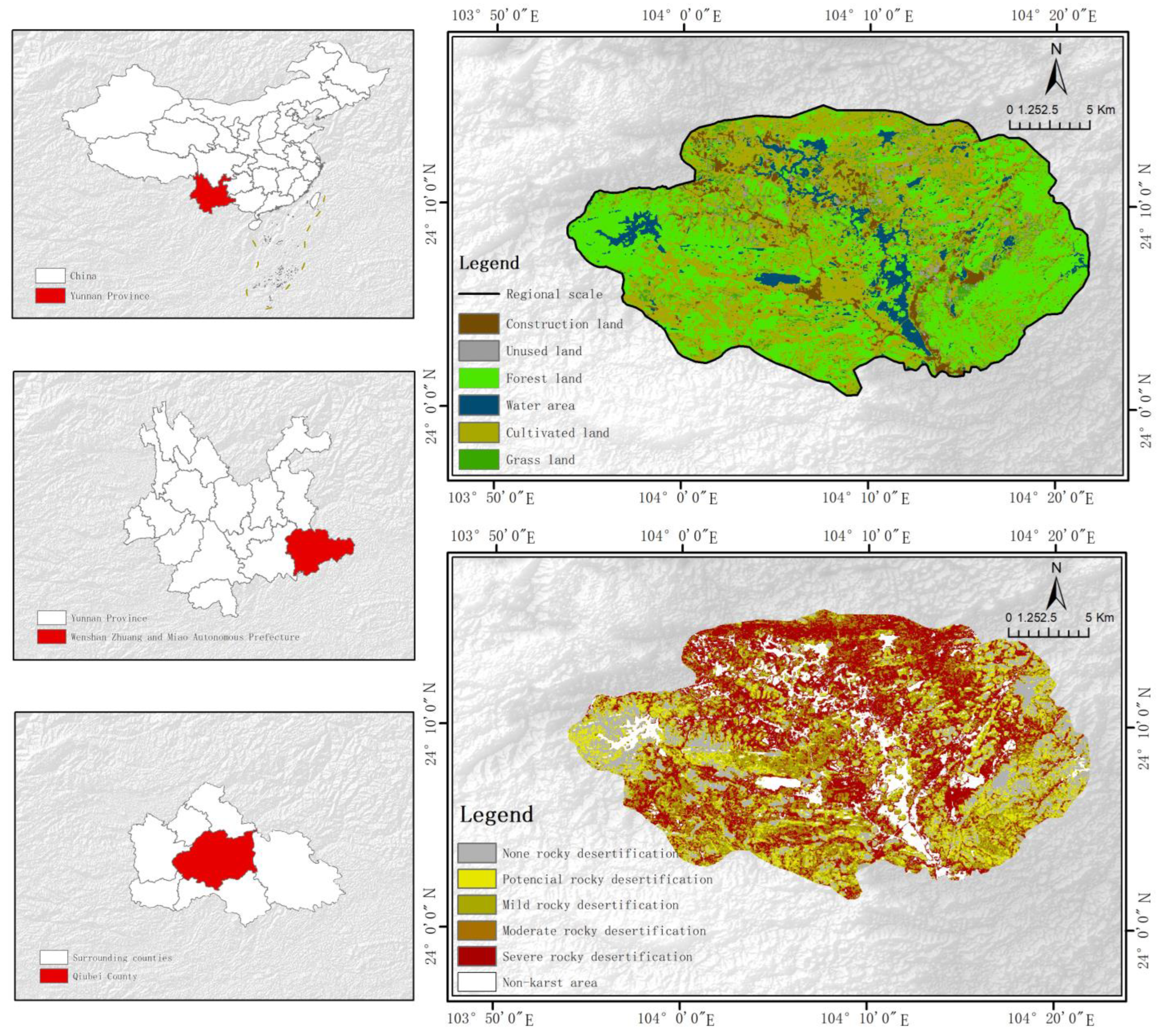
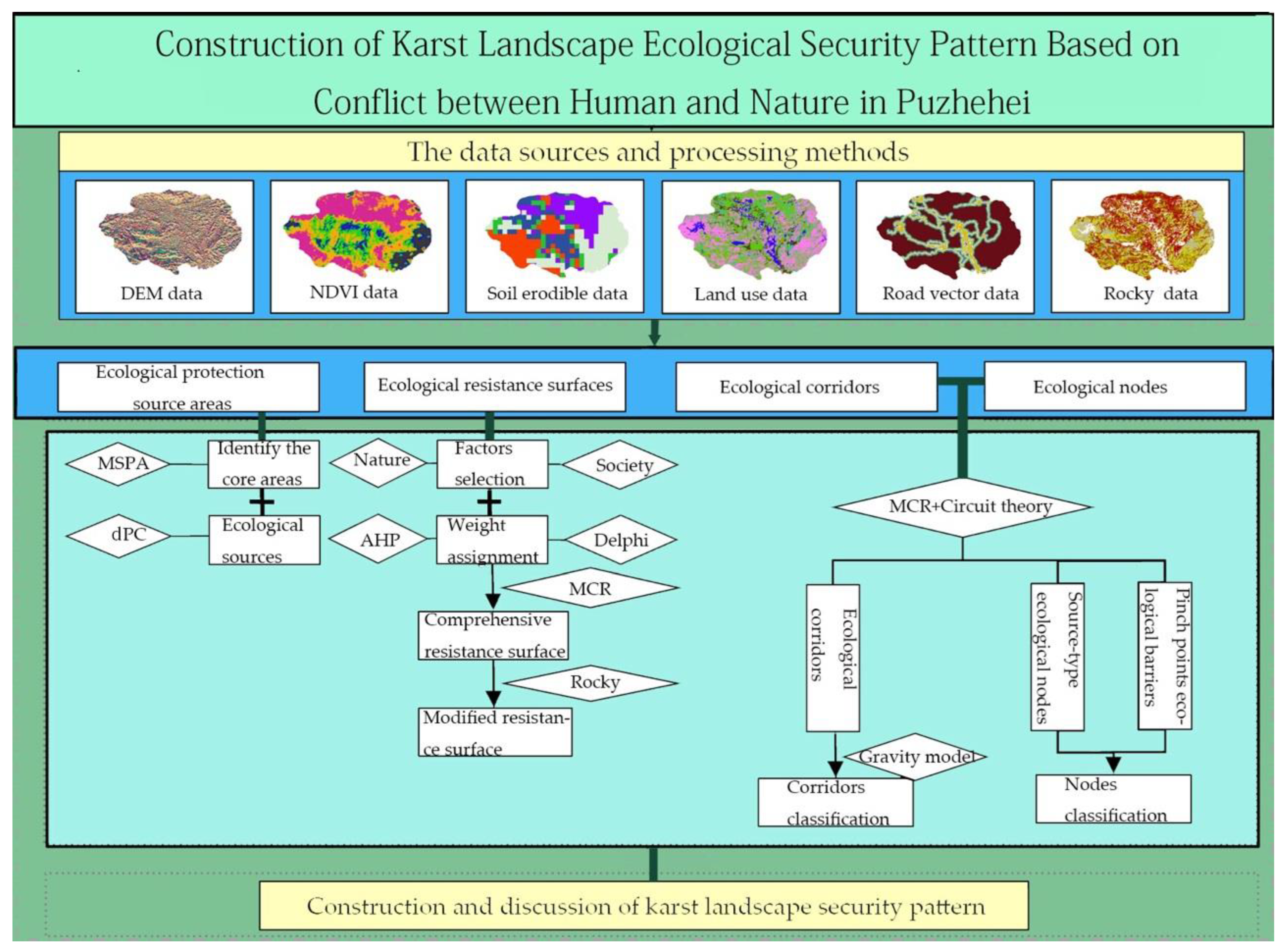
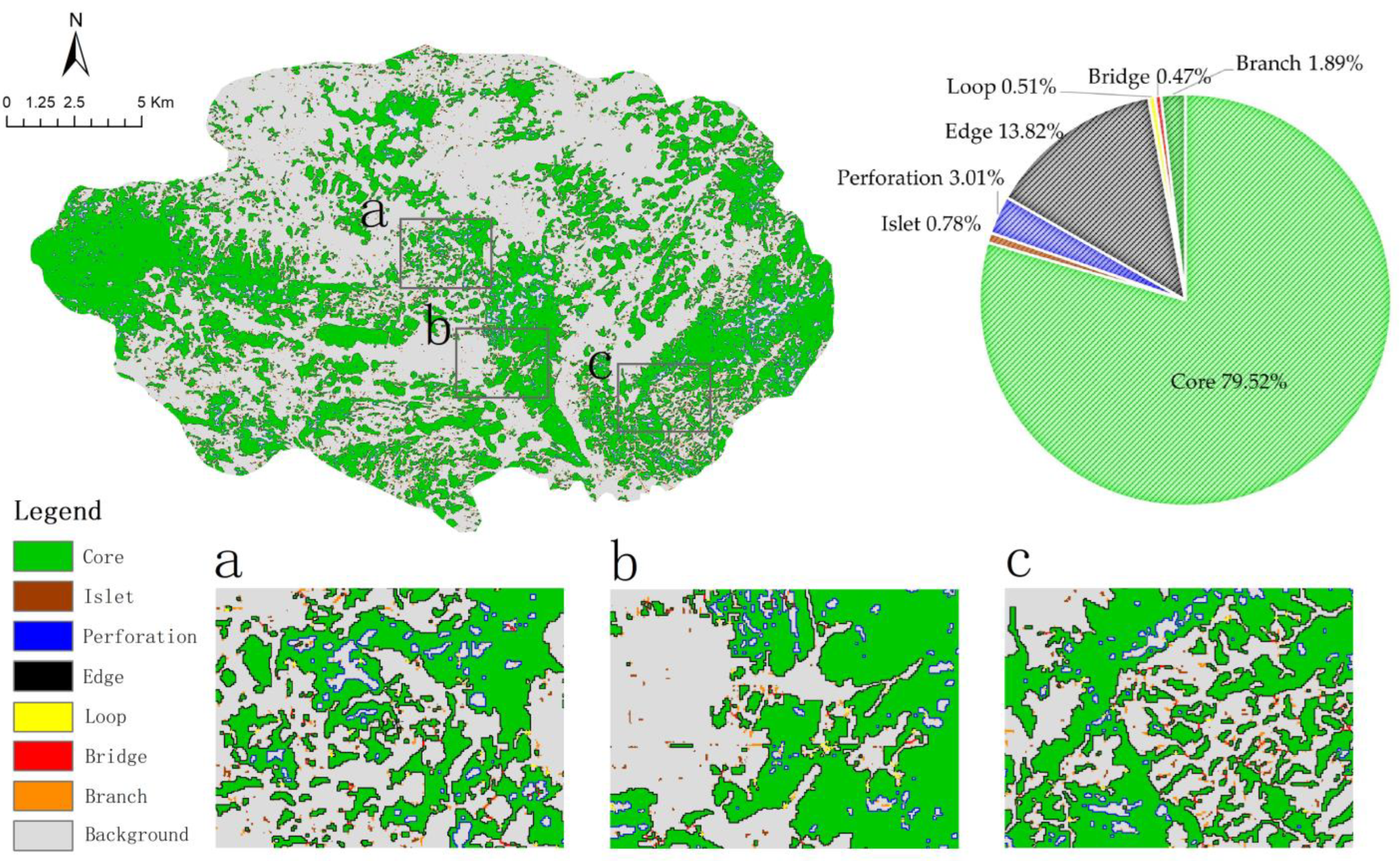


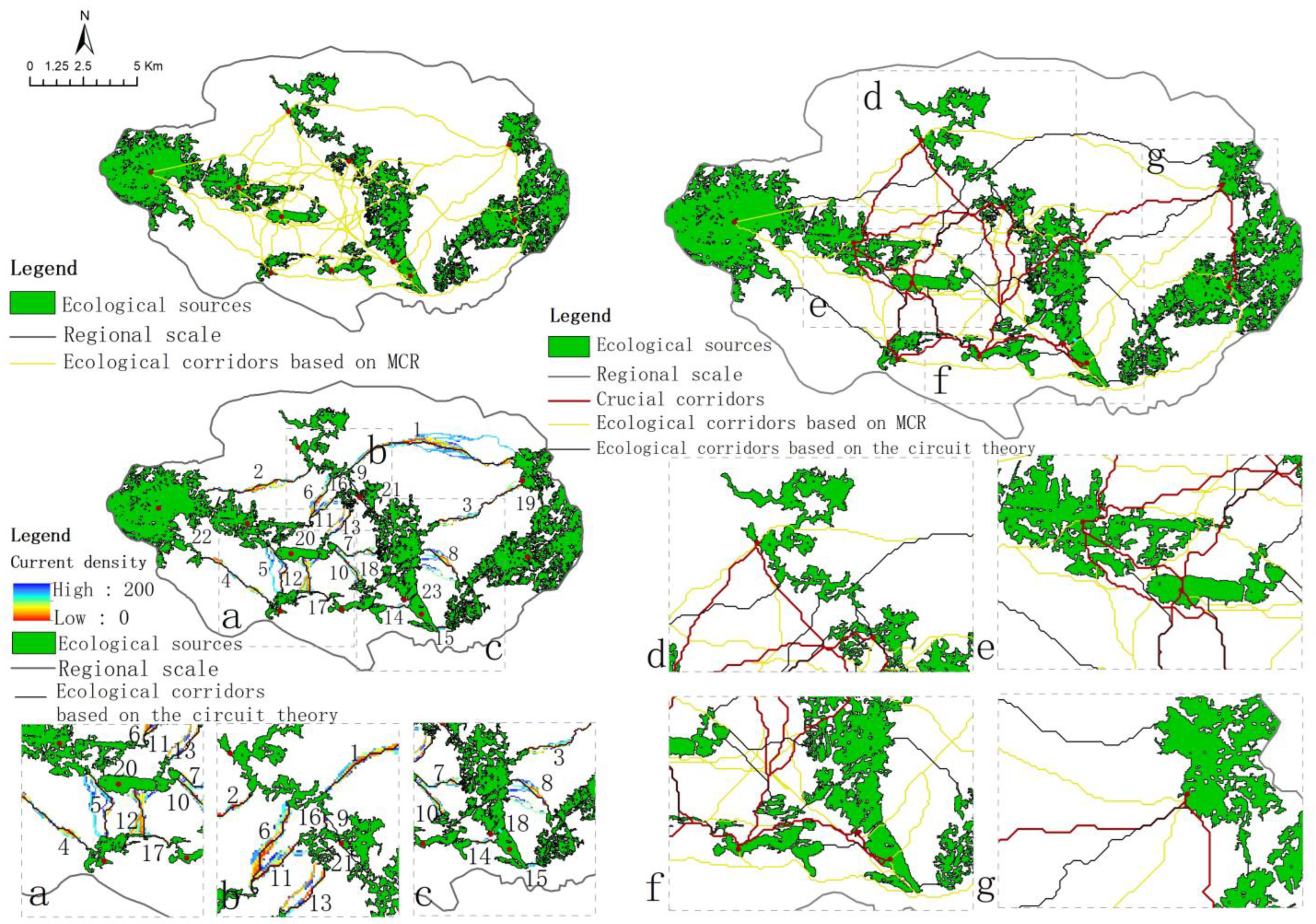
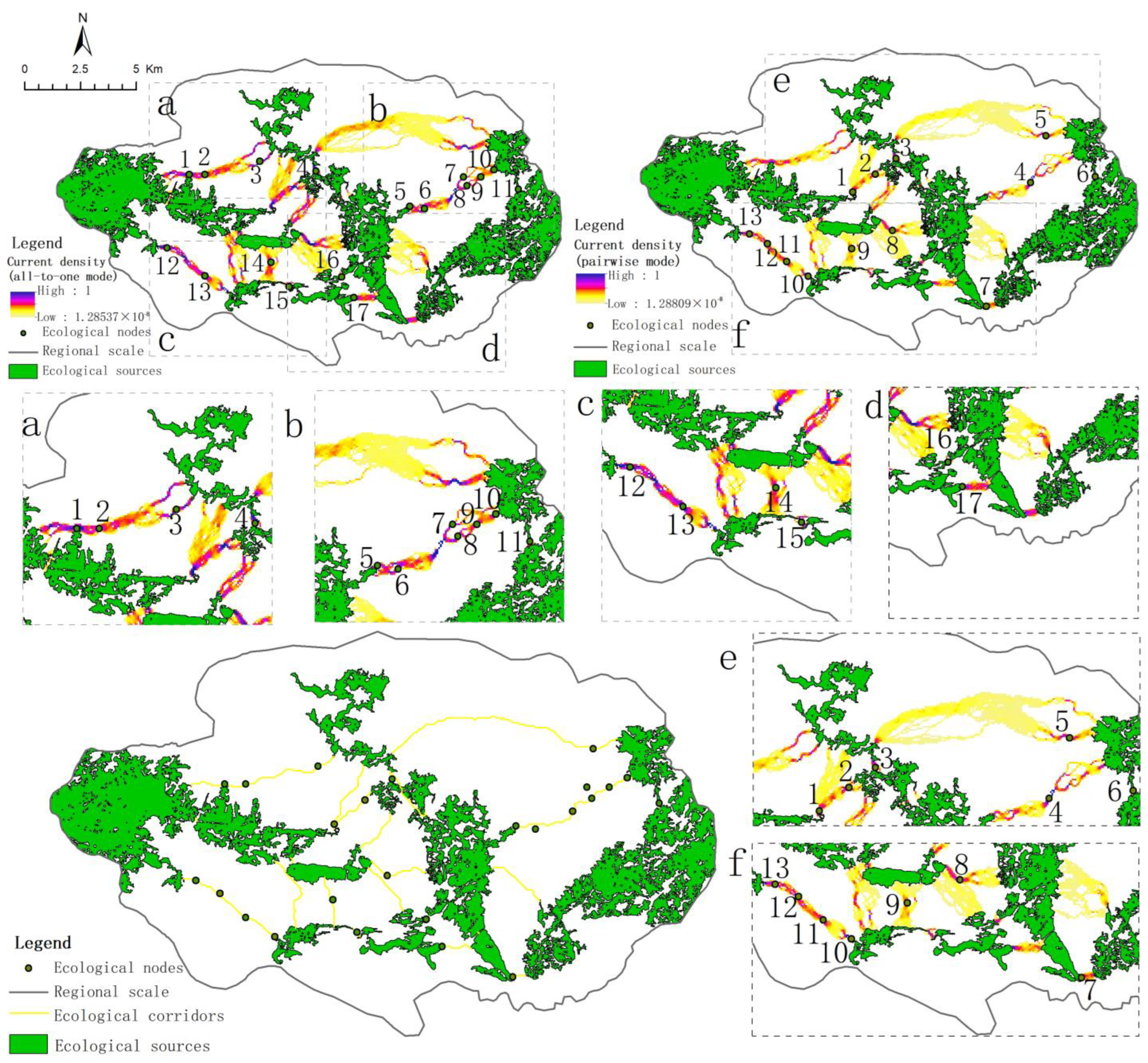
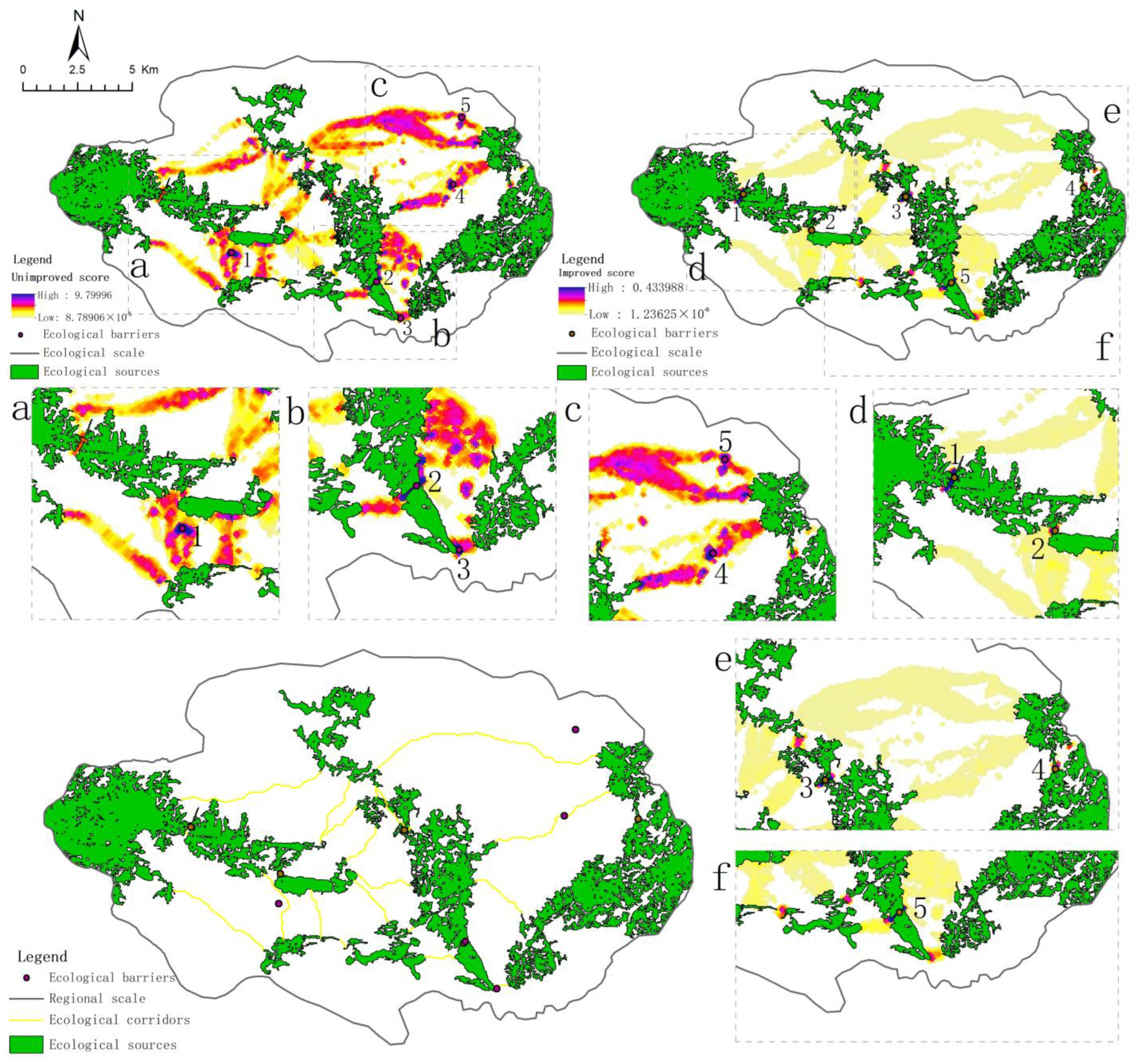
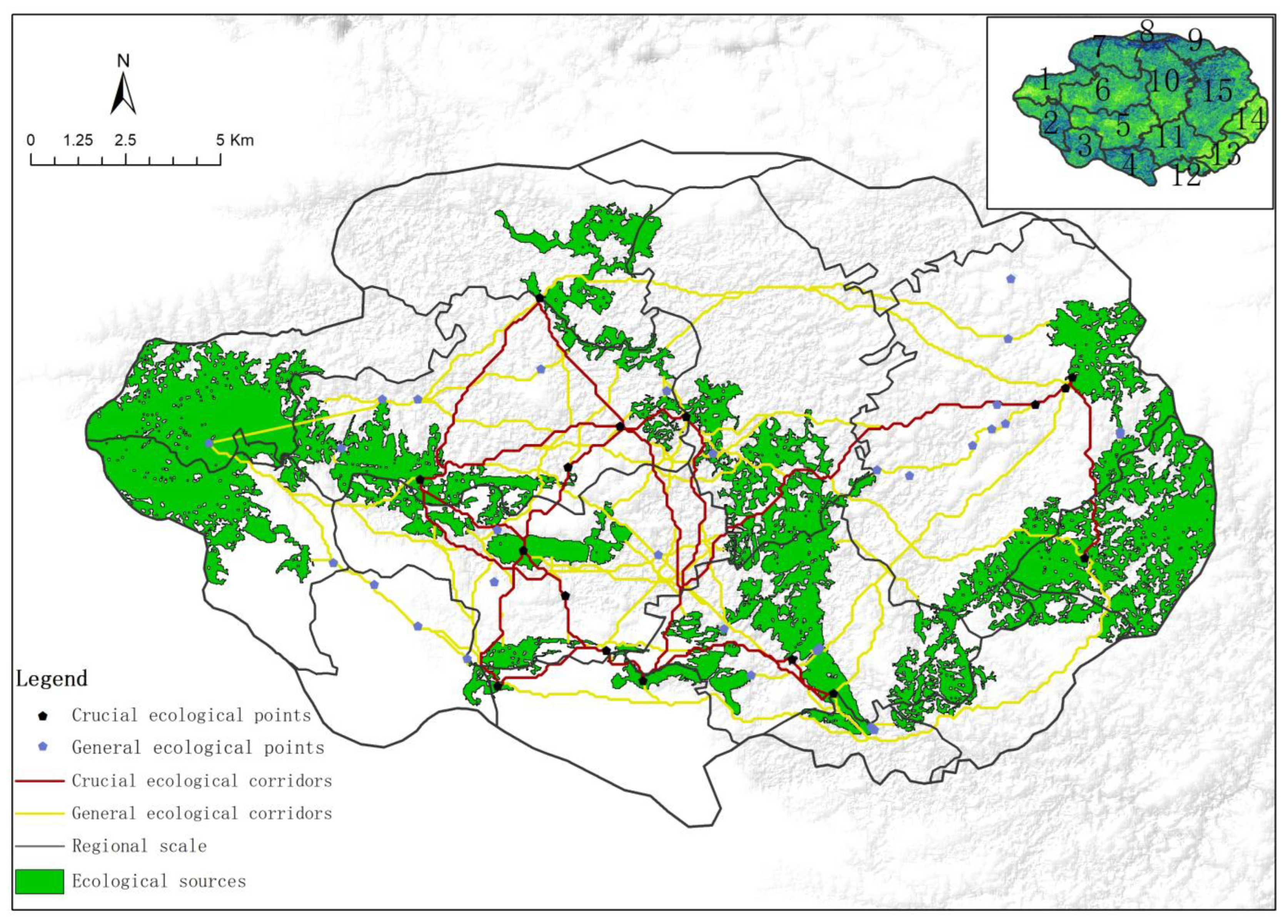
| Resistance Types | Resistance Factors | Resistance Level | Weight | ||||
|---|---|---|---|---|---|---|---|
| 1 | 2 | 3 | 4 | 5 | |||
| Natural environmental factors | Topographic location index | 0.7899–1.0740 | 0.6632–0.7899 | 0.5489–0.6632 | 0.4409–0.5489 | 0.2864–0.4409 | 0.3115 |
| Slope (°) | ≥46° | 36–45° | 26–35° | 16–25° | 0–15° | 0.2130 | |
| Slope direction | Plane (-1) north (0–22.5) (337.5–360) | Northwest (22.5–67.5), Northwestern (292.5–337.5) | East (67.5–112.5), west (247.5–292.5) | Southeast (112.5–157.5), Southwestern (202.5–247.5) | South (157.5–202.5) | 0.0628 | |
| Hydrological analysis | 1–77 | 77–130 | 130–183 | 183–264 | 264–348 | 0.0893 | |
| NDVI (%) | 80–100 | 60–80 | 40–60 | 20–40 | 0–20 | 0.1193 | |
| Soil erodibility | >0.0204 | 0.0149–0.0204 | 0.0143–0.0149 | 0.0114–0.0143 | <0.0114 | 0.0612 | |
| Socio-economic factors | Land use | Forest land, water area | Grassland | Cultivated land | Unused land | Construction land | 0.0347 |
| Road buffer zones | >400 | 300–400 | 200–300 | 100–200 | <100 | 0.0490 | |
| Construction land buffer zones | >400 | 300–400 | 200–300 | 100–200 | <100 | 0.0245 | |
| Cultivated land buffer zones | >400 | 300–400 | 200–300 | 100–200 | <100 | 0.0347 | |
| Landscape Types | Area/km2 | The Proportion of MSPA Landscape Types Area/% | The Proportion of Total Area/% 364.8644 |
|---|---|---|---|
| Core | 132.5291 | 79.52% | 36.32% |
| Islet | 1.2911 | 0.78% | 0.35% |
| Perforation | 5.0212 | 3.01% | 1.38% |
| Edge | 23.0371 | 13.82% | 6.31% |
| Loop | 0.8575 | 0.51% | 0.24% |
| Bridge | 0.7787 | 0.47% | 0.21% |
| Branch | 3.1425 | 1.89% | 0.86% |
| Total | 166.6572 | 100% | 45.67% |
| Number | Patch Number | Patch Importance Index | Area/km2 |
|---|---|---|---|
| 1 | 20 | 52.3485 | 10.3311 |
| 2 | 26 | 44.8115 | 20.1055 |
| 3 | 17 | 34.8515 | 20.9108 |
| 4 | 24 | 34.2455 | 2.5871 |
| 5 | 23 | 30.5922 | 1.5565 |
| 6 | 14 | 18.1885 | 6.6360 |
| 7 | 27 | 14.1676 | 1.8099 |
| 8 | 12 | 14.0698 | 2.0097 |
| 9 | 15 | 11.2695 | 2.4178 |
| 10 | 10 | 10.9068 | 3.7875 |
| 11 | 6 | 10.5786 | 5.1231 |
| Ecological Source Areas Interaction Matrix Constructed Based on the Gravity Model | |||||||||||
|---|---|---|---|---|---|---|---|---|---|---|---|
| 1 | 2 | 3 | 4 | 5 | 6 | 7 | 8 | 9 | 10 | 11 | |
| 1 | 0 | 2.3850 | 0.7308 | 12.9011 | 3.0525 | 2.0896 | 23.1563 | 4.2395 | 3.8941 | 1.2655 | 1.3457 |
| 2 | 0 | 0.4274 | 1.8713 | 0.9189 | 0.8921 | 2.2689 | 1.5424 | 1.0086 | 13.2688 | 0.6370 | |
| 3 | 0 | 1.2350 | 1.3526 | 3.1784 | 0.4718 | 0.9068 | 1.7658 | 0.3181 | 0.9251 | ||
| 4 | 0 | 10.7706 | 3.9073 | 5.0729 | 6.6753 | 9.5275 | 1.1548 | 2.1088 | |||
| 5 | 0 | 4.2818 | 1.5982 | 2.5632 | 7.8276 | 0.6465 | 1.1789 | ||||
| 6 | 0 | 1.2093 | 5.4604 | 9.6484 | 0.7534 | 5.1436 | |||||
| 7 | 0 | 2.0888 | 1.9575 | 1.0697 | 0.7815 | ||||||
| 8 | 0 | 5.2561 | 1.4962 | 4.7159 | |||||||
| 9 | 0 | 0.7798 | 3.1282 | ||||||||
| 10 | 0 | 0.5946 | |||||||||
| 11 | 0 | ||||||||||
Disclaimer/Publisher’s Note: The statements, opinions and data contained in all publications are solely those of the individual author(s) and contributor(s) and not of MDPI and/or the editor(s). MDPI and/or the editor(s) disclaim responsibility for any injury to people or property resulting from any ideas, methods, instructions or products referred to in the content. |
© 2024 by the authors. Licensee MDPI, Basel, Switzerland. This article is an open access article distributed under the terms and conditions of the Creative Commons Attribution (CC BY) license (https://creativecommons.org/licenses/by/4.0/).
Share and Cite
Li, C.; Wang, J.; Liu, X.; Xu, K. Construction of Karst Landscape Ecological Security Pattern Based on Conflict between Human and Nature in Puzhehei. Sustainability 2024, 16, 908. https://doi.org/10.3390/su16020908
Li C, Wang J, Liu X, Xu K. Construction of Karst Landscape Ecological Security Pattern Based on Conflict between Human and Nature in Puzhehei. Sustainability. 2024; 16(2):908. https://doi.org/10.3390/su16020908
Chicago/Turabian StyleLi, Chunhua, Jin Wang, Xincen Liu, and Kejian Xu. 2024. "Construction of Karst Landscape Ecological Security Pattern Based on Conflict between Human and Nature in Puzhehei" Sustainability 16, no. 2: 908. https://doi.org/10.3390/su16020908
APA StyleLi, C., Wang, J., Liu, X., & Xu, K. (2024). Construction of Karst Landscape Ecological Security Pattern Based on Conflict between Human and Nature in Puzhehei. Sustainability, 16(2), 908. https://doi.org/10.3390/su16020908





